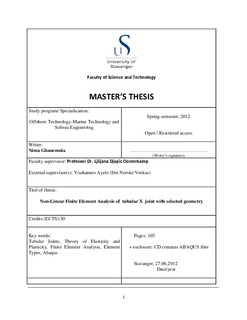| dc.contributor.author | Ghanem Nia, Nima | |
| dc.date.accessioned | 2012-10-16T14:57:41Z | |
| dc.date.available | 2012-10-16T14:57:41Z | |
| dc.date.issued | 2012 | |
| dc.identifier.uri | http://hdl.handle.net/11250/182994 | |
| dc.description | Master's thesis in Offshore Technology | no_NO |
| dc.description.abstract | “Tubular Joints” play a very important and quite vital role in most of the marine structures; we can see maybe hundreds of them in every even simple jacket or steel platforms. It is obvious that having full control about capacity and strength of tubular joints would be very worthy to have good knowledge about total performance of the structure. During recent years the application of the finite element (FE) method has become very popular in the analyses of different types of welded circular tubular joints. The rapid development of commercial FE programs and computation facilities has extended the analyses from elastic to elasto-plastic, from linear to non-linear, from uniplanar joints to multiplanar joints, from un cracked joints to cracked joints, from traditional study of stress distribution, SCF calculation and load displacement behavior of a joint to the assessment of the ultimate capacity of a joint (21). Due to complexity of these kinds of elements, Lots of world level codes and standards have covered some chapters about tubular joints and their capacity, and in some of them the mentioned relations and formula are extremely conservative and are not showing the real ability of the joints. As mentioned FE analysis has opened new horizons to tubular joints capacity. In these technical notes first off all I am trying make a good introduction about what we have already about tubular joints in different standards, comparing different mentioned relations and formula and general classifications of the joints, after that we will a choose real case for our study, a X joints from a real jacket located in north sea. We discuss the concept of theory of elasticity and theory of plasticity in detail later on and finally we are aiming to perform elastic and also a plastic analysis on that specific joint.
We will perform linear and non-linear finite element analysis by very powerful FE software which is called ABAQUS, ways of meshing and choosing element types are always important concern in each FE analysis. In addition of performing FE analysis we will perform some studies about different kinds of element type and meshing sizes. Comparing of these results would be a interesting guide for choosing optimum way of meshing, Since as we know different types of elements and meshing have direct relation with needed time and a skilled FE analyst can choose the optimum way. | no_NO |
| dc.language.iso | eng | no_NO |
| dc.publisher | University of Stavanger, Norway | no_NO |
| dc.relation.ispartofseries | Masteroppgave/UIS-TN-IKM/2012; | |
| dc.subject | tubular joint | no_NO |
| dc.subject | finite element | no_NO |
| dc.subject | theory of elasticity & plactisity | no_NO |
| dc.subject | Abaqus | no_NO |
| dc.subject | offshore teknologi | no_NO |
| dc.title | Non-linear finite element analysis of tubular X joint with selected geometry | no_NO |
| dc.type | Master thesis | no_NO |
| dc.subject.nsi | VDP::Technology: 500::Marine technology: 580::Offshore technology: 581 | no_NO |
